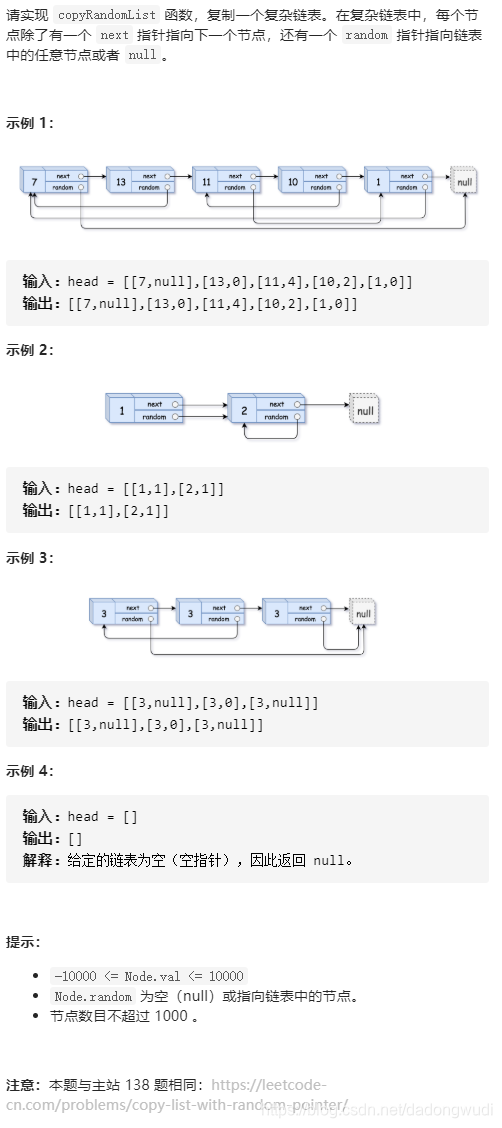【问题描述】[中等]

【解答思路】
1. 暴力 直接复制
将链表从头节点一个一个复制下去,
在根据记录的总长度num,遍历原来的每个节点的random到尾节点个数count,然后顺序遍历找到新链表的该指针在num-count上 。
时间复杂度:O(N^2) 空间复杂度:O(N)
class Solution {public Node copyRandomList(Node head) {if(head==null) return head;Node newHead=new Node(head.val);Node keep=newHead;Node node=head.next;int num=1;//记录节点数while(node!=null){keep.next=new Node(node.val);node=node.next;keep=keep.next;num++;}keep.next=null;Node newn=newHead;Node oldn=head;//n r 定位randomNode n;Node r;int count;while (oldn!=null){n= oldn.random;//进行循环找到酒链表random指向的位置nr=newHead;count=0;//计算出旧链表n距离尾节点个数while (n!=null){n=n.next;count++;}//计算旧的random在链表中的位置 利用新旧链表新旧位置相同的原理for(int res=num-count;res>0;res--){r=r.next;}newn.random=r;//遍历新旧链表oldn=oldn.next;newn=newn.next;}return newHead;}
}作者:zhao-1z
链接:https://leetcode-cn.com/problems/fu-za-lian-biao-de-fu-zhi-lcof/solution/javaliang-chong-xie-fa-by-zhao-1z/2. HashMap O(N)空间


**时间复杂度:O(N) 空间复杂度:O(N) **

/*
// Definition for a Node.
class Node {public int val;public Node next;public Node random;public Node() {}public Node(int _val,Node _next,Node _random) {val = _val;next = _next;random = _random;}
};
*/
public class Solution {// Visited dictionary to hold old node reference as "key" and new node reference as the "value"HashMap<Node, Node> visited = new HashMap<Node, Node>();public Node getClonedNode(Node node) {// If the node exists thenif (node != null) {// Check if the node is in the visited dictionaryif (this.visited.containsKey(node)) {// If its in the visited dictionary then return the new node reference from the dictionaryreturn this.visited.get(node);} else {// Otherwise create a new node, add to the dictionary and return itthis.visited.put(node, new Node(node.val, null, null));return this.visited.get(node);}}return null;}public Node copyRandomList(Node head) {if (head == null) {return null;}Node oldNode = head;// Creating the new head node.Node newNode = new Node(oldNode.val);this.visited.put(oldNode, newNode);// Iterate on the linked list until all nodes are cloned.while (oldNode != null) {// Get the clones of the nodes referenced by random and next pointers.newNode.random = this.getClonedNode(oldNode.random);newNode.next = this.getClonedNode(oldNode.next);// Move one step ahead in the linked list.oldNode = oldNode.next;newNode = newNode.next;}return this.visited.get(head);}
}作者:LeetCode
链接:https://leetcode-cn.com/problems/copy-list-with-random-pointer/solution/fu-zhi-dai-sui-ji-zhi-zhen-de-lian-biao-by-leetcod/3. HashMap O(N)空间
遍历第一遍链表,我们不考虑链表之间的相互关系,仅仅生成所有节点,然后把它存到 HashMap 中,h(val) 作为 key,Node 作为 value。
遍历第二遍链表,将之前生成的节点取出来,更新它们的 next 和 random 指针。
时间复杂度:O(N) 空间复杂度:O(N)
public Node copyRandomList(Node head) {if (head == null) {return null;}HashMap<Node, Node> map = new HashMap<>();Node h = head;while (h != null) {Node t = new Node(h.val); map.put(h, t);h = h.next;}h = head;while (h != null) {if (h.next != null) {map.get(h).next = map.get(h.next);}if (h.random != null) {map.get(h).random = map.get(h.random);}h = h.next;}return map.get(head);
}作者:windliang
链接:https://leetcode-cn.com/problems/copy-list-with-random-pointer/solution/xiang-xi-tong-su-de-si-lu-fen-xi-duo-jie-fa-by-32/4. HashMap O(N)空间
只遍历一次链表。
核心思想就是延迟更新它的 next。
1 -> 2 -> 3
用 cur 指向已经生成的节点的末尾
1 -> 2
^
c
然后将 3 构造完成
最后将 2 的 next 指向 3
1 -> 2 -> 3
^
c
期间已经生成的节点存到 HashMap 中,第二次遇到的时候直接从 HashMap 中拿
时间复杂度:O(N) 空间复杂度:O(N)
public Node copyRandomList(Node head) {if (head == null) {return null;}HashMap<Node, Node> map = new HashMap<>();Node h = head;Node cur = new Node(-1); //空结点,dummy 节点,为了方便头结点计算while (h != null) {//判断当前节点是否已经产生过if (!map.containsKey(h)) {Node t = new Node(h.val);map.put(h, t);}//得到当前节点去更新它的 random 指针Node next = map.get(h);if (h.random != null) {//判断当前节点是否已经产生过if (!map.containsKey(h.random)) {next.random = new Node(h.random.val);map.put(h.random, next.random);} else {next.random = map.get(h.random);}}//将当前生成的节点接到 cur 的后边cur.next = next;cur = cur.next;h = h.next;}return map.get(head);
}5. O(1)空间 (用原链表的 next 域保存新生成的节点)
主要解决的问题就是我们生成节点以后,当更新它的 random 的时候,怎么找到之前生成的节点,前两种解法用了 HashMap 全部存起来,这里的话可以利用原来的链表的指针域。
主要需要三步。
- 生成所有的节点,并且分别插入到原有节点的后边
- 更新插入节点的 random
- 将新旧节点分离开来


时间复杂度:O(N) 空间复杂度:O(1)
public Node copyRandomList(Node head) {if (head == null) {return null;}Node l1 = head;Node l2 = null;//生成所有的节点,并且分别插入到原有节点的后边while (l1 != null) {l2 = new Node(l1.val);l2.next = l1.next;l1.next = l2;l1 = l1.next.next;}//更新插入节点的 randoml1 = head;while (l1 != null) {if (l1.random != null) {l1.next.random = l1.random.next;}l1 = l1.next.next;}l1 = head;Node l2_head = l1.next;//将新旧节点分离开来while (l1 != null) {l2 = l1.next;l1.next = l2.next;if (l2.next != null) {l2.next = l2.next.next;}l1 = l1.next;}return l2_head;
}/*
// Definition for a Node.
class Node {public int val;public Node next;public Node random;public Node() {}public Node(int _val,Node _next,Node _random) {val = _val;next = _next;random = _random;}
};
*/
public class Solution {public Node copyRandomList(Node head) {if (head == null) {return null;}// Creating a new weaved list of original and copied nodes.Node ptr = head;while (ptr != null) {// Cloned nodeNode newNode = new Node(ptr.val);// Inserting the cloned node just next to the original node.// If A->B->C is the original linked list,// Linked list after weaving cloned nodes would be A->A'->B->B'->C->C'newNode.next = ptr.next;ptr.next = newNode;ptr = newNode.next;}ptr = head;// Now link the random pointers of the new nodes created.// Iterate the newly created list and use the original nodes' random pointers,// to assign references to random pointers for cloned nodes.while (ptr != null) {ptr.next.random = (ptr.random != null) ? ptr.random.next : null;ptr = ptr.next.next;}// Unweave the linked list to get back the original linked list and the cloned list.// i.e. A->A'->B->B'->C->C' would be broken to A->B->C and A'->B'->C'Node ptr_old_list = head; // A->B->CNode ptr_new_list = head.next; // A'->B'->C'Node head_old = head.next;while (ptr_old_list != null) {ptr_old_list.next = ptr_old_list.next.next;ptr_new_list.next = (ptr_new_list.next != null) ? ptr_new_list.next.next : null;ptr_old_list = ptr_old_list.next;ptr_new_list = ptr_new_list.next;}return head_old;}
}6. O(1)空间 (用原链表的 random域保存新生成的节点)
可以利用原链表的 random 域把新生成的节点保存起来。
主要还是三个步骤。
- 生成所有的节点,将它们保存到原链表的 random 域,同时利用新生成的节点的 next 域保存原链表的 random。
- 更新新生成节点的 random 指针。
- 恢复原链表的 random 指针,同时更新新生成节点的 next 指针。
时间复杂度:O(N) 空间复杂度:O(1)
public Node copyRandomList(Node head) {if (head == null) {return null;}Node l1 = head;Node l2 = null;//生成所有的节点,讲它们保存到原链表的 random 域,//同时利用新生成的节点的 next 域保存原链表的 random。while (l1 != null) {l2 = new Node(l1.val);l2.next = l1.random;l1.random = l2;l1 = l1.next;}l1 = head;//更新新生成节点的 random 指针。while (l1 != null) {l2 = l1.random;l2.random = l2.next != null ? l2.next.random : null;l1 = l1.next;}l1 = head;Node l2_head = l1.random;//恢复原链表的 random 指针,同时更新新生成节点的 next 指针。while (l1 != null) {l2 = l1.random;l1.random = l2.next;l2.next = l1.next != null ? l1.next.random : null;l1 = l1.next;}return l2_head;
}【总结】
1.思路1暴力O(N^2)-> 思路2.3.4 HashMap O(N)->思路5.6 复制链表O(1)
2.链表操作的核心思想就是,在改变某一个节点的指针域的时候,一定要把该节点的指针指向的节点用另一个指针保存起来,以免造成丢失。
3.链表 画图
转载链接:https://leetcode-cn.com/problems/copy-list-with-random-pointer/solution/xiang-xi-tong-su-de-si-lu-fen-xi-duo-jie-fa-by-32/
转载链接:https://leetcode-cn.com/problems/copy-list-with-random-pointer/solution/xiang-xi-tong-su-de-si-lu-fen-xi-duo-jie-fa-by-32/




![[剑指offer]面试题第[36]题[JAVA][二叉搜索树与双向链表][递归]](http://pic.xiahunao.cn/[剑指offer]面试题第[36]题[JAVA][二叉搜索树与双向链表][递归])



![[Leetcode][第1025题][JAVA][除数博弈][数学][递推]](http://pic.xiahunao.cn/[Leetcode][第1025题][JAVA][除数博弈][数学][递推])

![[Leetcode][第410题][JAVA][分割数组的最大值][动态规划][二分]](http://pic.xiahunao.cn/[Leetcode][第410题][JAVA][分割数组的最大值][动态规划][二分])



![[小技巧][Java]Arrays.fill() 初始化 二维数组](http://pic.xiahunao.cn/[小技巧][Java]Arrays.fill() 初始化 二维数组)



![[算法][算法复杂度]常用算法复杂度速查表](http://pic.xiahunao.cn/[算法][算法复杂度]常用算法复杂度速查表)
